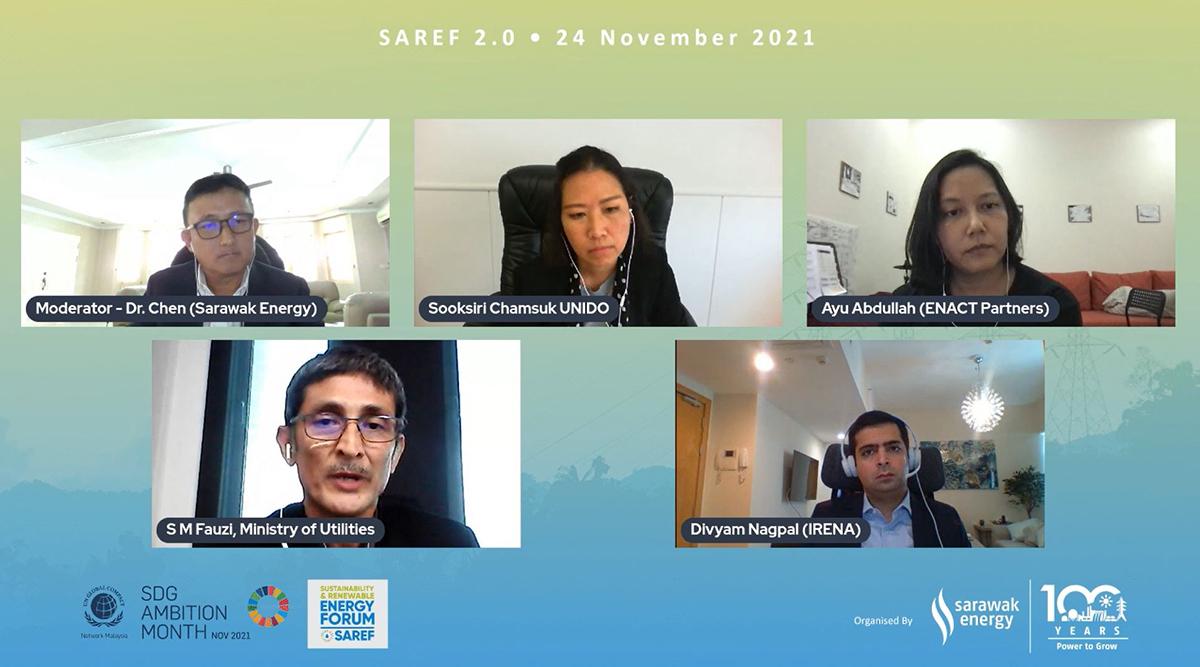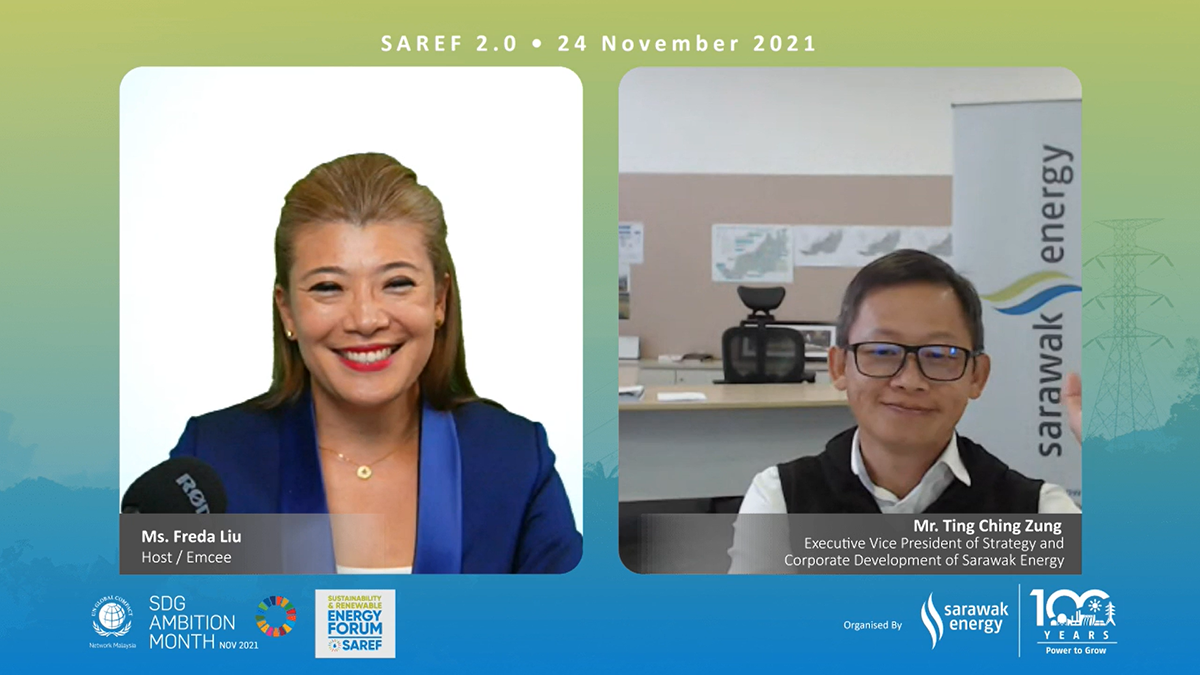

NEWS & UPDATES
SAREF 2.0 Progresses Discourse on Energy Poverty Eradication and Talks Sarawak’s Development in Renewable Energy
KUCHING
8 DECEMBER 2021
More than 900 registered delegates joined virtually to listen to conversations on building a shared sustainable energy future at the second edition of the Sustainability and Renewable Energy Forum or SAREF 2.0.
Held over the afternoon of 24 November, SAREF 2.0 highlighted efforts and progress in reducing energy poverty across ASEAN at a panel session on “Energy Poverty Eradication” as the region works towards achieving the United Nations Sustainable Development Goal (UN SDG) 7 of ensuring access to affordable, reliable, sustainable and modern energy for all.
Moderated by Sarawak Energy’s Vice President for Rural Electrification, Dr Chen Shiun, the panel comprised Syed Mohammad Fauzi Shahab, Director of Electricity Supply from Ministry of Utilities Sarawak; Sooksiri Chamsuk, Deputy Representative and Programme Officer for United Nations Industrial Development Organisation (UNIDO); Divyam Nagpal, Programme Officer for Energy Access, International Renewable Energy Agency (IRENA); and Ayu Abdullah, Co-Executive Director for Energy Action Partners.
Dr Chen opened the session by providing an overview of worldwide energy poverty and invited the panelists to discuss the challenges that lay ahead and the way forward to put an end to energy poverty across ASEAN in meeting the UN SDGs.
Syed Mohammad Fauzi shared Sarawak’s rural electrification journey and how the State aspires to eradicate energy poverty to be fully electrified by 2025 or earlier.
“In 2009, rural electrification coverage in Sarawak was only at 56%. Since then, about 130,000 rural households have been given access to 24-hour electricity, bringing rural electricity coverage to 95.8% in 2021. This has been made possible through a suite of strategies under the Accelerated Rural Electrification Masterplan, which includes innovative grid and off-grid solutions to power up rural communities,” he explained.
He added, “One of the rural electrification initiatives used in the most remote areas in Sarawak’s hinterland is Sarawak Alternative Rural Electrification Scheme or SARES which utilises solar or micro hybrid system to provide 24-hour reliable and renewable energy to the communities while waiting for grid accessibility.”
The panel also discussed regulatory barriers in providing energy access, and how enabling policies or regulations need to be friendly to enable participation from other stakeholders or the private sector, so everyone can play their role in making energy accessible to all.
Meanwhile Sarawak Energy’s Executive Vice President for Strategy and Corporate Development, Ting Ching Zung shared Sarawak Energy’s initiatives in renewable energy development to meet Sarawak and the region’s need for sustainable energy over a conversation on Expanding Sarawak’s Renewable Energy Footprint with host Freda Liu.
He said, “Our strategic corporate shift to renewable energy development has enabled us to transform our generation mix from 92% hydrocarbon to largely low-carbon renewable hydropower in just one decade. This has allowed us to pursue opportunities in emerging technologies and commercialisation of low-carbon solutions including solar, battery energy storage and hydrogen technologies.”
Ting shared that Sarawak Energy is developing a pilot 50MW floating solar at the reservoir of its 108MW Batang Ai Hydroelectric Plant to ride on the synergy between hydropower and solar.
The session also provided delegates an insight into Sarawak Energy’s 60MW Battery Energy Storage System pilot project to be installed at its Sejingkat Coal-Fired Power Plant to help enhance the resilience of Sarawak’s overall energy network system.
Ting explained that as the world is slowly transitioning from conventional thermal generation to include more intermittent renewable generation sources such as solar, energy storage is a key element for grid resilience. The Battery Energy Storage System or BESS will help to manage and optimise the operation of generation plants, further reducing grid carbon emissions.
He also talked about how hydrogen is recognised globally as a fuel of the future for green energy and a key enabler in energy decarbonisation.
Sarawak Energy now produces green hydrogen through electrolysis at its Pilot Integrated Hydrogen Plant and Refuelling Station in Kuching. The integrated production plant, commissioned in 2019, is Southeast Asia’s first such facility and aims to enhance knowledge in the area of green hydrogen production.
“Transitioning towards a low-carbon economy will require a credible mechanism for renewable energy players to report and track their commitments to renewables targets, and this is where REC or Renewable Energy Certificate comes into play. We launched Sarawak’s first REC at SAREF 1.0 and this allows greater participation from corporations in a more sustainable energy future,” Ting concluded.
Sarawak Energy’s SAREF is a biennial thought leadership campaign organised to bring the conversation on renewable energy and actionable solutions into Southeast Asia. Its inaugural forum took place in 2019, with SAREF 2.0 successfully held this year as Sarawak Energy celebrates its 100 years of powering Sarawak.


The panel speakers shared on “Energy Poverty Eradication” efforts across ASEAN.


Sarawak Energy’s Executive Vice President for Strategy and Corporate Development, Ting Ching Zung (right) discussed “Expanding Sarawak’s Renewable Energy Footprint” with host Freda Liu (left).